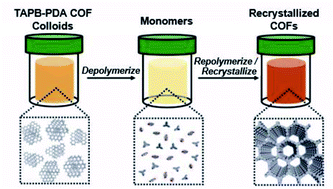Solvothermal depolymerization and recrystallization of imine-linked two-dimensional covalent organic frameworks†
Abstract
Mechanistic understanding into the formation and growth of imine-linked two-dimensional (2D) covalent organic frameworks (COFs) is needed to improve their materials quality and access larger crystallite sizes, both of which limit the promise of 2D COFs and 2D polymerization techniques. Here we report a previously unknown temperature-dependent depolymerization of colloidal 2D imine-linked COFs, which offers a new means to improve their crystallinity. 2D COF colloids form at room temperature but then depolymerize when their reaction mixtures are heated to 90 °C. As the solutions are cooled back to room temperature, the 2D COFs repolymerize and crystallize with improved crystallinity and porosity, as characterized by X-ray diffraction, infrared spectroscopy and N2 porosimetry. The evolution of COF crystallinity during the solvothermal depolymerization and repolymerization processes was characterized by in situ wide angle X-ray scattering, and the concentrations of free COF monomers as a function of temperature were quantified by variable temperature 1H NMR spectroscopy. The ability of a 2D COF to depolymerize under these conditions depends on both the identity of the COF and its initial materials quality. For one network formed at room temperature (TAPB-PDA COF), a first depolymerization process is nearly complete, and the repolymerization yields materials with dramatically enhanced crystallinity and surface area. Already recrystallized materials partially depolymerize upon heating their reaction mixtures a second time. A related 2D COF (TAPB-DMTA COF) forms initially with improved crystallinity compared to TAPB-PDA COF and then partially depolymerizes upon heating. These results suggest that both high materials quality and network-dependent properties, such as interlayer interaction strength, influence the extent to which 2D COFs resist depolymerization. These findings offer a new means to recrystallize or solvent anneal 2D COFs and may ultimately inform crystallization conditions for obtaining large-area imine-linked two-dimensional polymers from solution.



 Please wait while we load your content...
Please wait while we load your content...